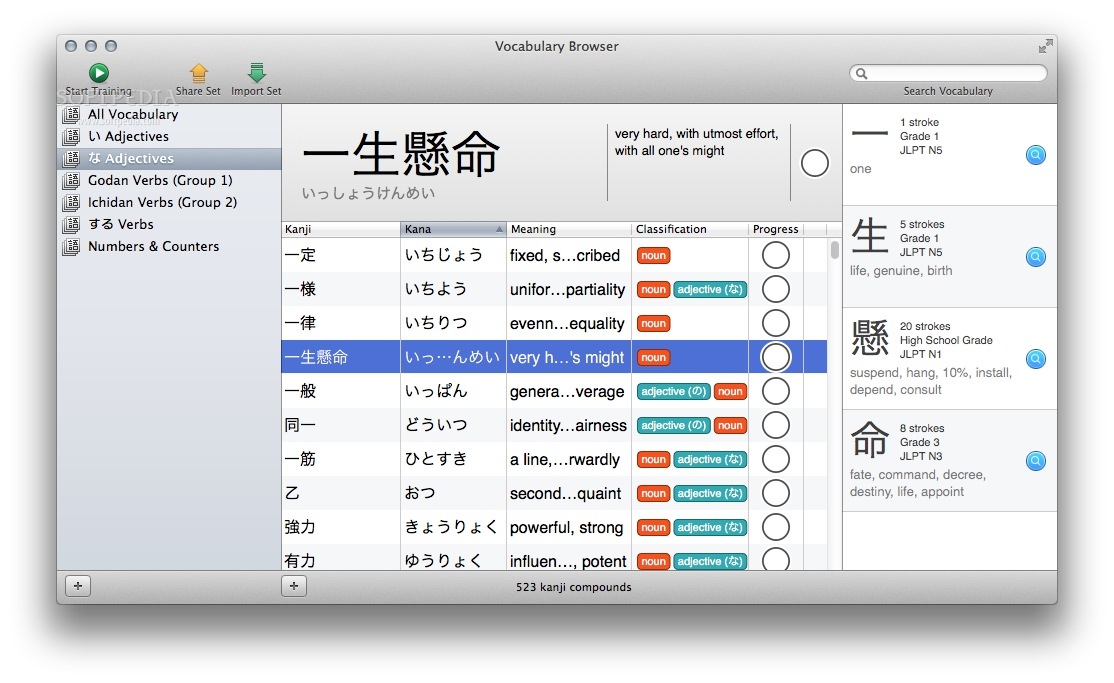

Using these radicals, Heisig argues that by making vivid and memorable stories, you can remember even complex kanji easily.Ī common and simple example of a kanji mnemonic is 男, the character for “man”. If the SUN and the MOON appeared in the sky together, that’d be pretty BRIGHT, right? Knowledge of radicals is also very helpful for looking up kanji in a dictionary.įor example, the kanji 明 (meaning “bright”) is made up of the two smaller parts 日 (“sun“) and 月 (“moon”). Radicals are the building blocks of kanji, and by learning to identify these constituent parts, you can “unpick” new and unfamiliar characters. (He calls them “primitive elements”, but radicals is a more commonly-used term). Heisig also puts a lot of focus on learning radicals - small parts which make up kanji. “But this one (象) "means ‘elephant’, and this one (牙) means ‘tusk’.”

“I don’t,” I said, pointing at the sign which had the word 象牙 on it. “Fran, why the hell do you know the Japanese word for ‘ivory’?” I got to show off this ability years later in Okinawa, when my good friend Karli and I were looking at some artefact: For example, the kanji character 行 means “go”, so Heisig gives it the English keyword “going”.īy learning the meanings of kanji, the learner can guess at unfamiliar words. To this end, he gives each kanji an English keyword. Heisig argues that before learning the readings of any kanji characters, it is more efficient to first learn the meanings. You’ll note that reading kanji (how to pronounce them) does not feature on this list.
IKANJI INSTAGRAM HOW TO
The Heisig approach can be summed up as follows:ģ) Memorise how to write kanji by making up descriptive mnemonic stories Heisig in his popular (and somewhat controversial) book ‘ Remembering the Kanji I: A complete course on how not to forget the meaning and writing of Japanese characters’. This is the kanji study method introduced by James W. When I got serious about learning kanji, in 2010, I did a bit of googling and stumbled across people talking about “the Heisig method”.

And traditional methods of learning kanji tend to focus on rote memorisation, which is very inefficient. That’s why students in Japan continue learning the jōyō kanji right up until the end of high school. The task of learning at least 2000 kanji is a major undertaking - even for Japanese people. There is even an official list of the 2136 kanji that all Japanese children learn by the end of secondary school, called the jōyō kanji (常用漢字, meaning “regular-use kanji”). To read Japanese fluently, a student must be able to understand at least 2000 kanji. For example, the kanji 木 means “tree” 重 means “heavy”.

Kanji, on the other hand, indicate meaning as well as sound. (Just like how the letter “B” doesn’t have any meaning by itself - it’s just a sound). Individual hiragana and katakana characters indicate sound only - the hiragana character あ makes the sound “a”, but it doesn’t have any meaning by itself. Written Japanese uses a mix of three “alphabets” - hiragana, katakana, and kanji (Chinese characters).
IKANJI INSTAGRAM PLUS
So here is the story of how I studied kanji, some suggestions for kanji practice, plus some advice from another friend who took a totally different approach to me. I don’t blame him.īut this slightly convoluted method is the thing that took my Japanese kanji knowledge from beginner to advanced. I told him that I was going to learn all 2136 common-use kanji by making up a mnemonic story for each one. I had a friend in 2011 who also lived in Japan and was also learning Japanese.


 0 kommentar(er)
0 kommentar(er)
